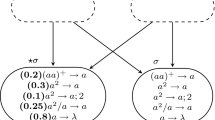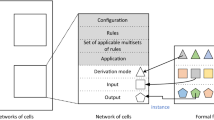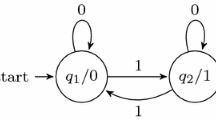Abstract
Since their first publication in 2006, spiking neural (SN) P systems have already attracted the attention of a lot of researchers. This might be owing to the fact that this abstract computing device follows basic principles known from spiking neural nets, but its implementation is discrete, using membrane computing background. Among the elementary properties which confer SN P systems their computational power one can count the unbounded fan-in (indegree) and fan-out (outdegree) of each “neuron”, synchronicity of the whole system, the possibility of delaying and/or removing spikes in neurons, the capability of evaluating arbitrary regular expressions in neurons in constant time and some others. In this paper we focus on the power of these elementary features. Particularly, we study the power of the model when some of these features are disabled. Rather surprisingly, even very restricted SN P systems keep their universal computational power. Certain important questions regarding this topic still remain open.






Similar content being viewed by others
References
Cavaliere M, Egecioglu O, Ibarra OH, Woodworth S, Ionescu M, Păun G (2007) Asynchronous spiking neural P systems. Technical Report 9/2007, Microsoft Research – University of Trento, Centre for Computational and Systems Biology
Chen H, Ishdorj T-O, Păun G, Pérez-Jiménez MJ (2006) Spiking neural P systems with extended rules. In: Gutiérrez-Naranjo MA et al (eds) Proceedings of fourth brainstorming week on membrane computing, Sevilla, Fenix Editora, pp 241–265
García-Arnau M, Pérez D, Rodríguez Patón A, Sosík P (2007) Spiking neural P systems: stronger normal forms. In: Gutiérrez-Naranjo MA et al (eds) Proceedings of fifth brainstorming week on membrane computing, Sevilla, Fenix Editora, pp 157–178
García-Arnau M, Pérez D, Rodríguez Patón A, Sosík P (2008) Spiking neural P systems: stronger normal forms. Int J Unconv Comput (to appear)
Gutiérrez-Naranjo MA, Păun G, Romero-Jiménez A, Riscos-Núnez A (eds) (2007) Proceedings of fifth brainstorming week on membrane computing, Sevilla, Fenix Editora
Gutiérrez-Naranjo MA, Păun G, Romero-Jiménez A, Riscos-Núnez A (eds) (2006) Proceedings of fourth brainstorming week on membrane computing, Sevilla, Fenix Editora
Ibarra OH, Păun A, Păun G, Rodríguez Patón A, Sosík P, Woodworth S (2007) Normal forms for spiking neural P systems. Theor Comput Sci 372(2–3):196–217
Ionescu M, Păun A, Păun G, Pérez-Jiménez MJ (2006a) Computing with spiking neural P systems: traces and small universal systems. In: 12th International meeting on DNA computing, vol 4287 of Lecture Notes in Computer Science. Springer-Verlag, Berlin, pp 1–16
Ionescu M, Păun G, Yokomori T (2006b) Spiking neural P systems. Fundam Inform 71(2–3):279–308
Maass W (2002) Computing with spikes. Special Issue on Foundations of Information Processing of TELEMATIK 8(1):32–36
Maass W, Bishop C (eds) (1999) Pulsed neural networks. MIT Press, Cambridge
Minsky M (1967) Computation – finite and infinite machines. Prentice Hall, Englewood Cliffs, New Jersey
Păun G (2002) Membrane computing – an introduction. Springer-Verlag, Berlin
Păun G (2007) Twenty six research topics about spiking neural P systems. In: Gutiérrez-Naranjo MA et al (eds) Proceedings of fifth brainstorming week on membrane computing, Sevilla, Fenix Editora, pp 263–280
Păun A, Păun G (2007) Small universal spiking neural P systems. Biosystems 90(1):48–60
Păun G, Pérez-Jiménez MJ, Rozenberg G (2006a) Spike trains in spiking neural P systems. Int J Found Comput Sci 17(4):975–1002
Păun G, Pérez-Jiménez MJ, Salomaa A (2006b) Bounding the indegree of spiking neural P systems. Technical Report 773, TUCS
The P systems web page. http://ppage.psystems.eu/. Retrieved on 5 May 2008
Acknowledgements
This research has been partially funded by the Spanish Ministry of Science and Education under project TIN2006-15595, by the Comunidad de Madrid (grant No. CCG06-UPM/TIC-0386 to the LIA research group), by the I3 Program, and by the Czech Science Foundation, grant No. 201/06/0567.
Author information
Authors and Affiliations
Corresponding author
Rights and permissions
About this article
Cite this article
García-Arnau, M., Pérez, D., Rodríguez-Patón, A. et al. On the power of elementary features in spiking neural P systems. Nat Comput 7, 471–483 (2008). https://doi.org/10.1007/s11047-008-9082-z
Published:
Issue Date:
DOI: https://doi.org/10.1007/s11047-008-9082-z




